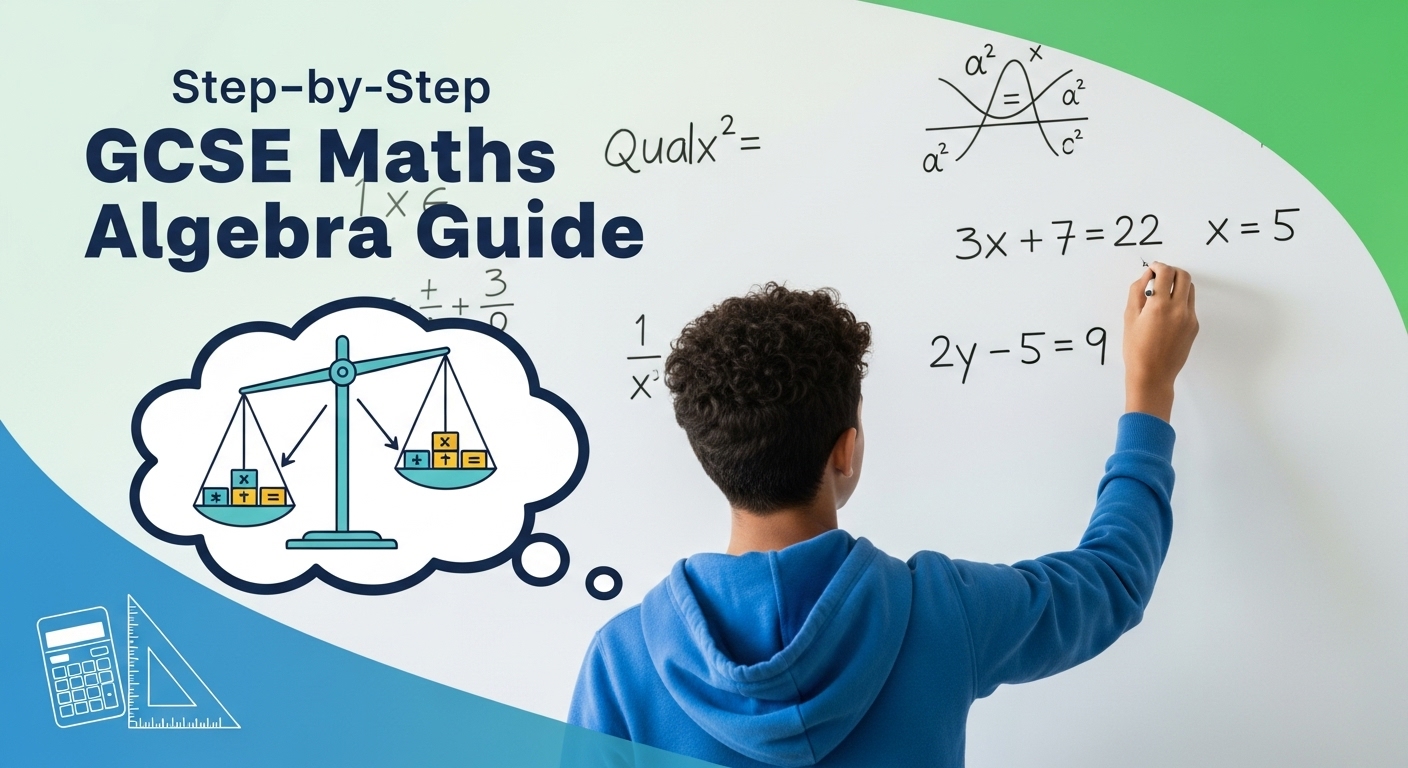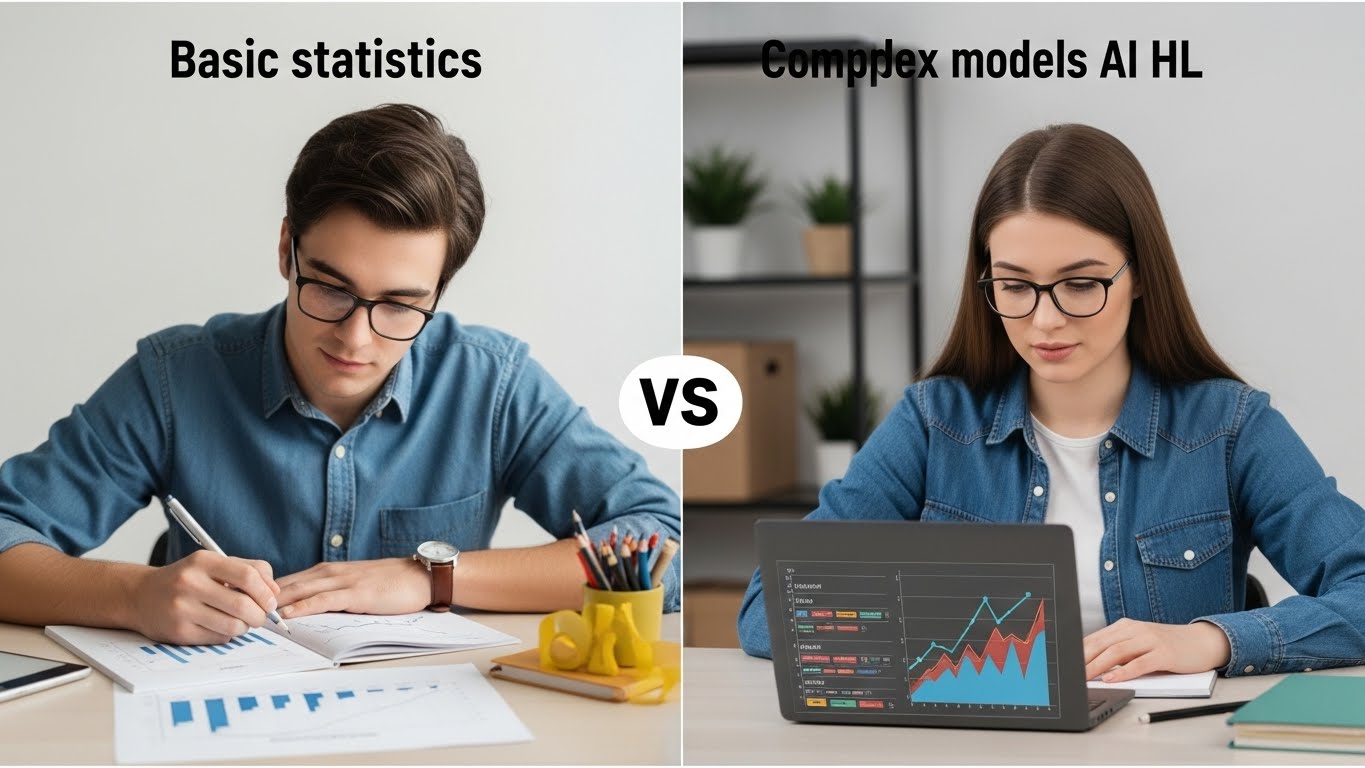Introduction
Algebra is one of the most important and sometimes feared parts of GCSE maths. However, it is also one of the most rewarding once you understand its logic. Mastering algebra helps you with other maths topics like geometry, trigonometry, and statistics.
This step-by-step GCSE maths algebra guide will help you simplify, solve, and understand algebraic expressions with ease. Whether you are just starting revision or brushing up before exams, these examples and methods will help you gain complete confidence.
Table of Contents
What Is Algebra?
Algebra is the language of maths. It uses letters (variables) to represent numbers so you can form general rules and solve problems efficiently.
For example:
If a banana costs £x and an apple costs £2, then buying three bananas and two apples costs 3x + 4.
It is that simple — algebra helps you generalize and solve unknowns.
GCSE Maths Algebra Topics Overview
Here is what you will typically cover in the GCSE syllabus:
- Simplifying expressions
- Expanding and factorising brackets
- Solving linear and quadratic equations
- Algebraic fractions
- Sequences and nth term
- Rearranging formulas
- Simultaneous equations
Understanding these foundations is crucial to achieving top marks in your GCSE maths exam.
Step 1: Simplifying Expressions
Simplifying expressions means combining like terms (terms that share the same variable and power).
Example:
Simplify: 3x + 4x – 2y + y
✅ Combine like terms → (3x + 4x) + (–2y + y) = 7x – y
If brackets are involved, remember to remove them carefully using the distributive property.
Example:
Simplify: 2(x + 3) + 4x
✅ = 2x + 6 + 4x = 6x + 6
Step 2: Expanding Brackets
When expanding, multiply each term inside the brackets by the term outside.
Example:
Expand: 3(x + 5)
✅ = 3×x + 3×5 = 3x + 15
Two brackets (double expansion):
Expand: (x + 4)(x + 2)
✅ = x×x + x×2 + 4×x + 4×2 = x² + 6x + 8
Step 3: Factorising Expressions
Factorising is the reverse of expanding; you find what was multiplied to make the expression.
Example:
Factorise: 6x + 9
✅ Find the common factor (3): 3(2x + 3)
Quadratic example:
x² + 5x + 6 → factors of 6 that add to 5 are 2 and 3.
✅ (x + 2)(x + 3)
Step 4: Solving Linear Equations
To solve linear equations, isolate the variable.
Example:
Solve: 3x + 5 = 11
✅ Subtract 5 → 3x = 6
✅ Divide by 3 → x = 2
With brackets:
Solve: 2(x + 3) = 10
✅ Expand → 2x + 6 = 10
✅ Subtract 6 → 2x = 4
✅ Divide by 2 → x = 2
Step 5: Solving Quadratic Equations
Quadratic equations include x² terms. There are three main ways to solve them:
Factorisation:
x² + 5x + 6 = 0
✅ (x + 2)(x + 3) = 0 → x = –2 or x = –3
Completing the square:
x² + 6x + 5 = 0 → (x + 3)² – 4 = 0 → x + 3 = ±2 → x = –5 or –1
Quadratic formula:
For ax² + bx + c = 0,
x = [–b ± √(b² – 4ac)] / (2a)
Step 6: Algebraic Fractions
To simplify algebraic fractions, factorise and cancel standard terms.
Example:
Simplify: (x² + 5x + 6) / (x + 2)
✅ Factorise numerator → (x + 2)(x + 3)
✅ Cancel (x + 2) → x + 3
Step 7: Substitution and Formula Rearranging
Substitution means replacing variables with numbers.
Example:
If y = 3x + 4, find y when x = 2.
✅ y = 3(2) + 4 = 10
Rearranging formulas helps isolate variables:
Example:
Make x the subject of y = 2x + 5
✅ y – 5 = 2x → x = (y – 5)/2
Common Algebra Mistakes
Avoid these frequent errors:
- Forgetting to change the sign when moving terms across the equals sign.
- Not expanding brackets correctly.
- Mixing up + and – signs.
- Forgetting to divide every term when simplifying.
Double-check your work line by line; accuracy is key!
Practice Questions with Solutions
Question 1: Simplify: 4x + 3 – 2x + 7
✅ 2x + 10
Question 2: Solve: 5x – 4 = 11
✅ Add 4 → 5x = 15 → Divide by 5 → x = 3
Question 3: Expand and simplify: (x + 2)(x + 3)
✅ x² + 5x + 6
Question 4: Solve quadratic: x² – 7x + 10 = 0
✅ (x – 5)(x – 2) = 0 → x = 5 or 2
How Mathzem Helps You Master Algebra
Mathzem offers a dedicated GCSE maths algebra course that transforms theory into practice.
Here is what you get for free:
- Interactive video lessons on simplifying, expanding, and solving.
- Practice quizzes for every skill level.
- Step-by-step solutions explained visually.
- Personalized learning dashboard to track progress.
Before you buy another workbook, explore Mathzem’s free GCSE maths resources; it is everything you need to build absolute confidence in algebra.
FAQs About GCSE Maths Algebra
What is the easiest way to learn GCSE algebra?
Start with the basics (simplifying and expanding) and gradually move to equations. Use Mathzem’s guided lessons for interactive learning.
Do I need to memorise algebra formulas?
Understanding is more important. Learn how each formula is derived using Mathzem’s breakdowns.
How much algebra appears in the GCSE exam?
Around 20–30% of the exam covers algebra-related questions — mastering it gives you a significant advantage.
Where can I practice algebra problems for free?
You can access free algebra courses and quizzes on Mathzem to strengthen your understanding.
How much algebra appears in the GCSE maths exam?
Roughly a third of the GCSE maths paper includes algebraic content — from basic equations to problem-solving.
What is the best way to improve my algebra?
Consistent practice. Use past papers, online resources, and formula sheets to strengthen weak areas.
Should I memorise formulas?
Yes, but focus on understanding when and how to use them — not just remembering them.
Conclusion
Algebra does not have to be intimidating. Once you learn its logic, it becomes a predictable and rewarding part of maths.
By following this step-by-step GCSE maths algebra guide, practising past papers, and understanding mark schemes, you will gain both accuracy and confidence.
Start small, stay consistent, and celebrate progress along the way every equation solved is a step closer to exam success.
Ready to master algebra?
Start your free GCSE maths algebra course on Mathzem today.






